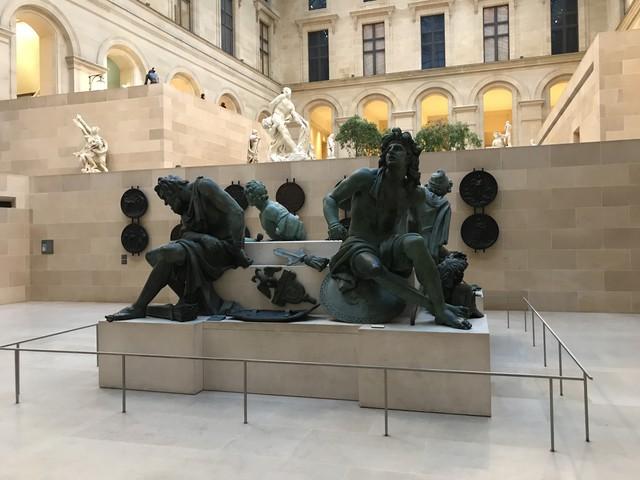Captives

Martin VAN DEN BOGAERT, known as DESJARDINS
From the pedestal of the statue of the Place des Victoires, these captives represent nations defeated by Louis XIV at the peace of Nijmegen (1679). Each expresses a different feeling in the test of captivity: revolt, hope, resignation or despondency
Captives, bronze figures larger than life, symbolize the four nations defeated in the Nijmegen treaties. Each represents an age of man and a distinct feeling of captivity. Spain is a beardless young man with long, fiery hair. The body naked and straightened, the face and the eyes raised towards the sky indicate the hope. The Empire is a bearded old man, dressed in an ancient tunic. His head bowed, his body bends under resigned despondency. Holland is a man still young, with masculine features and a short beard. The naked body ready to pounce, the shoulder brought forward in a defiant attitude and the fierce face, he rebels. Brandenburg is a mature man, dressed like an ancient barbarian (like the Farnese Prisoners, antique marbles much appreciated by artists). The hand clasping the mantle, the sagging right shoulder, the contracted face express the pain. The general orientation of the Captives to the right makes it possible to turn around the pedestal in the direction of clockwise. Desjardins marvelously knew how to diversify the figures, alternating characters young and old, naked and dressed, straightened or bent, and varying the postures of the legs and arms.
© Tourblink
The theme of the Captives is widespread in Roman art. The trophies that La Feuillade had added in 1685, helmets, shields, signs, beams, halberds, oars ... reinforce the analogy with the ancient triumphs. In France, there is a prestigious antecedent, the Four Captives (Louvre Museum) executed by Pierre Franqueville to flank the pedestal of the equestrian statue of Henry IV on the Pont Neuf. The contemptuous iconography of the monument became unwelcome at the mercy of alliances and struck the spirit of the Enlightenment. Under the Revolution, the gilded bronze statue of the king was melted but the Captives, perceived as victims of absolute power, were spared and the chains that hindered them were broken. Worn to the Louvre in 1790, they were then placed in the Invalides (1804-1962) and in the park of Sceaux, before winning the Louvre in 1992.